
The rise of digital assets revolutionized finance, creating new investment opportunities. Mastering both how to buy cryptocurrency for beginners as well as knowing where to store cryptocurrency are essential steps. Ownership together with security rely on private keys — encrypted strings functioning as access codes. Managing these effectively safeguards funds, ensures long-term peace of mind.
What Are Digital Currencies, Why Do They Need Protection?
Digital currencies are virtual money recorded on decentralized blockchains. Unlike traditional currencies controlled by banks, they put users in direct control. This decentralization offers freedom, and transparency but comes with responsibilities.
Private keys verify ownership. Whoever holds them controls the funds. Losing them means losing access; sharing them risks theft. Managing credentials is the most crucial aspect of digital finance.
With no central authority, no customer support, no recovery options for lost keys, securing digital assets is critical. Comprehending risks along with best practices is essential for protecting wealth in this space.
Risks of Inadequate Security
- Cyber threats. Hackers target poorly secured funds. Phishing attacks trick users into revealing credentials, while malware steals information. Billions have been lost from exchanges, and insecure platforms. Even top-tier services face breaches, underscoring the need for vigilance.
- Human error. Mistakes, like misplacing credentials or failing to back up recovery phrases, cause significant losses. Many users permanently lose funds by discarding hard drives or forgetting passwords.
- Centralized platform vulnerabilities. Relying on centralized platforms introduces risks. Exchanges are prime hacker targets. Breaches at Mt. Gox and Coincheck highlight the dangers of trusting third-party services with investments.
What You Will Learn in This Article
This guide explores securing digital holdings, offers actionable advice tailored to all experience levels. Whether you’re a beginner managing small amounts or an advanced investor with a substantial portfolio, you’ll learn to:
- Grasp storage methods: compare online as well as offline options, each with pros and cons;
- Evaluate tools, services: assess hardware devices, software applications, other solutions;
- Avoid common mistakes: recognize pitfalls like weak passwords, unsecured networks, unreliable platforms;
- Implement best practices: Use strategies like diversifying methods, enabling multi-factor authentication.
Key Considerations for Secure Digital Asset Management
- Accessibility vs. Security. Balancing convenience with security is crucial. Online solutions are suitable for daily transactions but carry higher risks. Offline methods provide superior protection for long-term holding but require careful managing to avoid physical loss.
- Backup, recovery. Have a recovery plan. Back up recovery phrases in secure locations, like encrypted drives or safes. Use multiple backups for redundancy.
- Advanced security features. Leverage tools like multi-signature authorization, requiring multiple approvals for transactions, or biometric authentication for added security.
Empowering Users to Protect Their Wealth
Digital currencies offer immense opportunities but require careful security. This guide empowers users with tools, and strategies to protect their holdings. Following these practices minimizes risks, enhances comprehending, builds a secure foundation for long-term success.
Proactive steps to secure digital wealth aren’t optional—they’re essential. With the right knowledge along with practices, navigating this dynamic space becomes safe, and confident.
Why Storage Matters in the Crypto World
Choosing where to store cryptocurrency isn’t just about convenience; it’s a critical decision impacting fund safety in a vulnerable environment. Digital assets operate on decentralized networks, granting autonomy but placing security responsibility on users. Without intermediaries like banks, there’s no fallback when issues arise, making robust measures essential.

The Irreversible Nature of Transactions
Once completed, digital transactions can’t be undone. This finality, while ensuring system integrity, turns small mistakes into major losses. Sending assets to the wrong address is one of the most common errors. Unlike traditional banking, where payments can be reversed, digital systems have no such recourse. A recipient must agree to return funds—unlikely, especially in anonymous transactions.
Common Loss Scenarios
- Incorrect address entries: a single mistyped character can send funds into a void due to case-sensitive, complex addresses;
- Phishing attacks: fraudulent websites or apps trick users into authorizing transfers to malicious addresses;
- Accidental approvals: clicking malicious links or authorizing rogue transactions through connected apps can drain holdings instantly.
Double-checking details, verifying platform legitimacy are non-negotiable. A brief lapse in attention can result in permanent loss.
The Escalating Threat of Cybercrime
Cybercrime remains a persistent issue for digital asset users. Attackers employ increasingly sophisticated techniques to exploit vulnerabilities, steal funds.
Alarming Statistics
- Over $14 billion in assets were stolen globally in 2021, a 79% rise from the prior year;
- 20% of users report experiencing phishing attacks or theft attempts;
- Centralized platforms have lost billions to breaches, including Mt. Gox ($450 million), Coincheck ($534 million).
Common Cyber Threats
- Phishing scams: fake websites, emails, or chats designed to steal credentials or trick users into transferring funds;
- Malware: software installed to track inputs or intercept sensitive information;
- Exchange Breaches: Centralized platforms, holding large volumes of funds, are prime hacker targets.
Proactively protect assets by using secure devices, avoiding suspicious links, regularly updating software to close vulnerabilities.
The Individual’s Role in Security
In traditional finance, institutions provide layers of protection like fraud detection, account recovery. In digital finance, all responsibility falls on users. Security knowledge as well as diligence are essential to safeguarding holdings.
Key Responsibilities
- Protect credentials: secure access codes, recovery phrases, backups;
- Verify platforms: use well-reviewed tools or exchanges for managing assets;
- Adopt advanced security: enable two-factor authentication (2FA), multi-signature approvals, biometric verification when possible.
Neglecting these measures often leads to irreversible losses, underscoring the need for careful management.
Practical Risk Mitigation
Protecting digital wealth effectively requires combining best practices with reliable tools.
Actionable Steps
- Use trusted tools: choose platforms with strong reputations, multi-layer encryption, device whitelisting;
- Backup access information: create secure backups of credentials in multiple formats, store them safely.
- Separate holdings: use easily accessible methods for frequent transactions, but keep long-term holdings offline or in secure systems;
- Stay Informed: Learn about emerging threats, scams, protective measures regularly.
The High Stakes of Digital Finance
Digital asset security is a critical responsibility. Unlike centralized systems, digital finance leaves accountability solely with the user, which can be both empowering as well as daunting. Knowing transaction irreversibility, recognizing cybercrime threats, embracing your role as the first defense line can significantly reduce risks. Proactive measures, careful planning, continuous learning are essential for managing, protecting digital wealth.
Types of Cryptocurrency Storage
Managing digital assets starts with knowing where to store cryptocurrency. Whether prioritizing daily accessibility or long-term security, selecting a method depends on specific needs. To determine ways to secure digital assets, evaluate two primary categories: online solutions for convenience, offline methods for enhanced security.
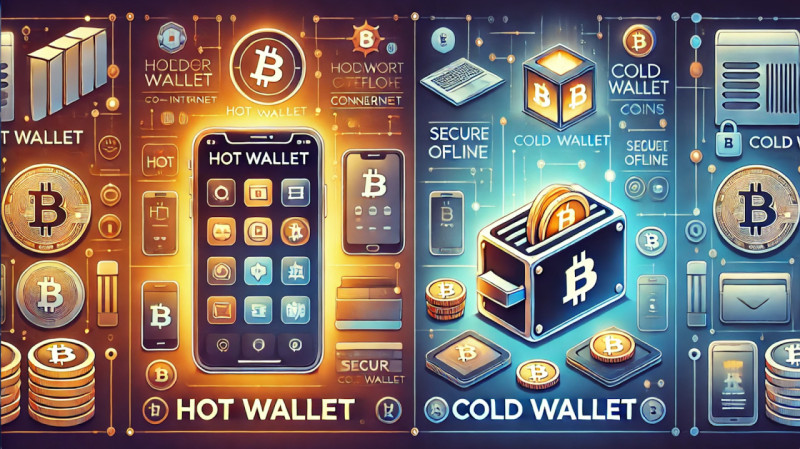
Hot Storage: Connected to the Internet
Hot storage remains online, offering easy access. These tools are typically for day-to-day transactions, favored for user-friendly interfaces, immediacy.
What It Is
Hot options are accessible via internet-connected devices like smartphones, computers, or browsers. They allow users to send, receive, manage funds with minimal effort.
Examples
- Mobile apps: Trust Wallet, MetaMask for portable access, smooth interfaces;
- Desktop programs: Exodus, Electrum for direct computer-based management;
- Web platforms: Binance, Coinbase for browser-based access.
| Advantages | Drawbacks | Best for |
| Convenience: seamless integration with exchanges, platforms | Vulnerability: online systems are targets for hackers, malware, phishing | Hot solutions suit small amounts used daily or for trading, prioritizing accessibility over security |
| Ease of use: intuitive for beginners | Device dependence: losing access to a phone or computer can compromise funds without proper backups | |
| Immediate access: ideal for frequent payments or transfers |
Cold Storage: Offline, Secure
Cold storage remains offline, reducing exposure to cyber threats. These methods prioritize security over convenience.
What It Is
Cold options involve systems storing access information offline, minimizing risks of hacking or phishing.
Examples
- Hardware devices: Ledger Nano X, Trezor Model T for physical security, encryption;
- Paper solutions: printed access codes or QR codes stored securely;
- Air-gapped systems: devices disconnected from the internet, often used by advanced users or institutions.
| Advantages | Drawbacks | Best for |
| Enhanced security: offline methods shield against cyberattacks, malware | Physical risks: devices or backups may be lost, damaged, or stolen if improperly stored | Cold solutions are ideal for long-term holding of significant amounts, prioritizing security over accessibility |
| Full control: users retain complete custody without third-party reliance | Inconvenience: unsuitable for frequent transactions due to manual reconnection or input requirements |
Choosing Between Hot and Cold Options
The choice depends on usage needs. Active traders as well as frequent users benefit from the speed, convenience of hot solutions. Long-term investors managing large amounts should prioritize the safety of cold methods. Combining both types ensures accessibility, security.
Knowing these methods' strengths along with weaknesses helps you make informed decisions about ways to secure digital assets. Balancing convenience with protection is key to managing assets effectively.
Popular Storage Solutions
Finding best storage solutions depends on goals, risk tolerance, how you use your holdings. Solutions cater to different needs, from beginner-friendly software to high-security physical tools. Here’s a breakdown of popular methods, their features, benefits, limitations.
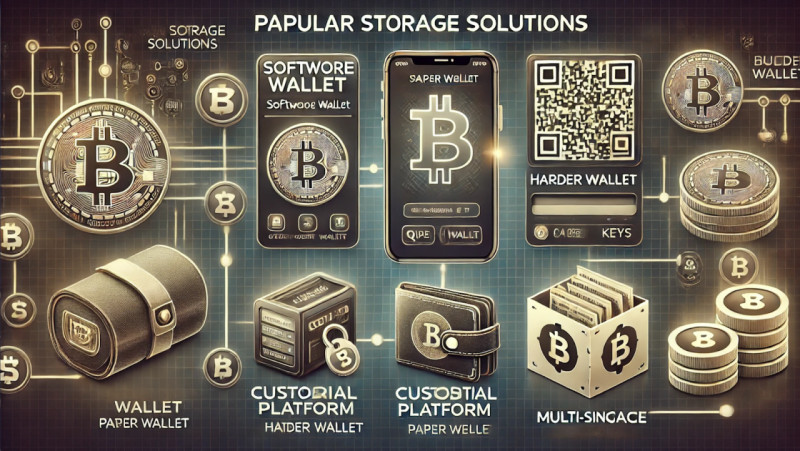
A. Software Solutions
Digital platforms provide easy access as well as user-friendly tools for managing assets.
Examples
- Trust Wallet: a mobile app supporting multiple digital assets with a simple interface;
- MetaMask: a browser extension along with mobile app for Ethereum, DeFi users;
- Exodus: desktop as well as mobile software with portfolio tracking, support for various coins.
Features
- Ease of use: intuitive interfaces with clear balance, transaction history displays;
- Multi-asset support: flexibility for diverse portfolios with support for many digital currencies;
- Security: encryption, backups, two-factor authentication (2FA).
Target Users
Best for beginners or those managing moderate holdings who can implement security practices like using safe devices, avoiding public networks if they know where to store cryptocurrency.
B. Hardware Devices
Physical tools keep sensitive data offline, offering strong protection from online threats.
Examples
- Ledger Nano X: compact, portable, supporting many assets via Bluetooth or USB;
- Trezor Model T: premium device with a touchscreen, advanced security.
Features
- Physical security: keeps data offline, safe from online risks;
- PIN protection: requires a unique code for access;
- Recovery options: includes backup phrases for restoring lost access.
Target Users
Ideal for serious investors prioritizing long-term safety over convenience. Less suitable for frequent transactions but among the safest options available.
C. Paper Solutions
Printed access credentials or QR codes stored on physical documents. Includes public as well as private details for managing assets, often in scannable formats.
Advantages
- Complete offline security: immune to online threats;
- Cost-effective: no need for hardware or software.
Risks
- Physical damage or loss: vulnerable to fire, water, or wear;
- Misplacement: poor storage could lead to loss or theft.
Use Cases
Works for users needing low-cost offline solutions, confident in securely storing physical documents.
D. Custodial Platforms
Third-party services manage funds on behalf of users.
Examples
- Coinbase: secure with easy integration for trading;
- Binance: combines management tools with trading features.
Features
- Beginner-friendly: simplifies asset access, management;
- Integrated trading: enables seamless buying, selling, staking.
Risks
- Third-party trust: users depend on platform security, stability;
- Failures: breaches or financial issues could cause access loss.
Target Users
Popular for beginners or those prioritizing convenience, though they surrender full control.
E. Multi-Signature Platforms
These setups require multiple approvals for transactions, adding security.
Definition
Multiple parties or keys must approve a transaction, preventing single-entity control.
Use Cases
- Group funds: secures shared accounts from unauthorized transfers;
- Business solutions: enhances accountability, reducing internal fraud.
Advantages
- Enhanced security: requires multiple approvals for transactions;
- Customizable thresholds: flexible control settings.
Risks
- Coordination delays: approvals can slow transactions;
- Complex setup: Requires technical knowledge.
Selecting the Best Option
The right method depends on how you use digital assets. Software solutions suit daily use, hardware devices as well as paper backups are best for long-term security, custodial platforms offer convenience with third-party trust, multi-signature setups excel for collaboration. Combining these approaches balances usability along with protection, helping you choose the best storage solution.
Factors to Consider When Choosing a Wallet
Selecting the right solution for managing digital wealth ensures safety together with usability. To decide about ways to secure digital assets, evaluate key factors like security, ease of access, compatibility. Here’s a breakdown of considerations to guide your choice.
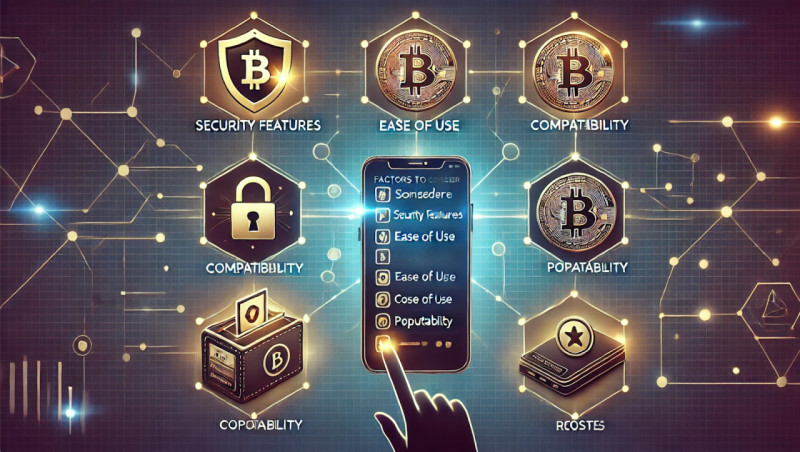
1. Security Features
Strong security is critical. Without it, funds face risks like theft, unauthorized access, or loss.
- Encryption: use options with advanced encryption to secure data, blocking unauthorized access;
- Two-Factor Authentication (2FA): add a second layer of security via codes from apps or texts;
- Offline options: maximize protection with solutions that keep assets disconnected from online threats;
- Backup, recovery: ensure clear methods for securely backing up access credentials.
High security is essential, especially for significant holdings or frequent transactions.
2. Ease of Use
A complex or hard-to-navigate solution can lead to errors, frustration. Accessibility matters, especially for beginners when they consider where to store cryptocurrency.
- User interface: choose platforms with clear, intuitive interfaces for easy transactions monitoring;
- Setup: simple instructions allow even first-time users to manage assets securely;
- Support: accessible help resources or customer support are vital for troubleshooting.
Match your choice to your expertise, look for solutions that simplify asset management.
3. Compatibility
Not all solutions support every digital asset or blockchain. Ensure compatibility with your holdings.
- Supported assets: multi-asset platforms are best for diverse portfolios;
- Blockchain networks: verify compatibility with networks like Ethereum or Bitcoin;
- Integration: look for seamless connections with exchanges, DeFi apps, or staking platforms.
Prioritize solutions that align with your portfolio together with usage needs.
4. Portability
Frequent access users should prioritize portability. Solutions must offer both physical as well as digital convenience.
- Mobile apps: on-the-go access for frequent transactions or portfolio tracking;
- Cross-device sync: use funds across desktop, mobile, hardware devices;
- Compact Devices: Hardware tools should be durable, portable, secure.
Portability is crucial for traders or active users requiring immediate access.
5. Costs
Costs vary from free software to premium tools. Balance expenses with features along with value.
- Free options: basic, free solutions work well for smaller amounts;
- Hardware tools: higher upfront costs offer unmatched security for large holdings;
- Subscriptions: premium services may charge recurring fees;
- Hidden costs: account for transaction, integration, or upgrade fees.
Casual users can choose free options, while long-term investors may benefit from premium solutions.
6. Reputation
Reputation reveals a platform’s reliability, performance. Research reviews before committing.
- User feedback: identify common issues or praised features through reviews;
- Endorsements: seek recommendations from trusted sources or experts;
- Track record: Check for past security breaches or disruptions;
- Transparency: trust platforms that provide clear details on security, fees, development.
Choosing reputable solutions minimizes the risk of unreliable or unsafe platforms.
Making an Informed Decision
Balancing these factors is key when deciding about ways to secure digital assets. Solutions with robust security, user-friendly design, compatibility protect assets while maintaining accessibility. By considering these aspects, you can confidently choose an option that meets your goals, ensures long-term safety for your digital wealth.
Best Practices for Cryptocurrency Storage
Managing digital wealth securely requires more than choosing the right solution. Adopting effective habits as well as best practices keeps investments safe from loss, theft, or mismanagement. Whether deciding about storage solution or improving your setup, these strategies reduce risks.
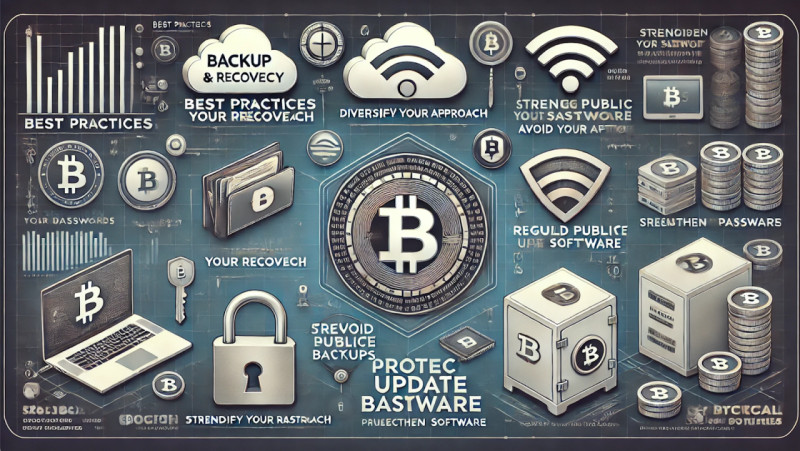
1. Backup, Recovery
Losing access credentials is a common cause of lost funds. Backing up recovery phrases, codes, other sensitive details ensures control over holdings.
- Recovery phrases: write down phrases generated by solutions, store securely in multiple locations;
- Durable materials: use metal plates to protect recovery phrases from physical damage;
- Secure storage: keep backups in safes or deposit boxes to prevent theft or loss.
A solid backup plan is essential if devices are lost, stolen, or damaged.
2. Diversify Your Approach
Relying on one method increases risk. Diversification ensures one failure doesn’t compromise all holdings.
- Multiple solutions: combine online and offline methods for flexibility along with security. When deciding where to store cryptocurrency, use online tools for transactions, offline for savings;
- Distribute assets: spread funds across platforms to avoid losing everything in one incident;
- Match use cases: choose methods based on purpose. Traders need quick access, while long-term investors prioritize security.
Diversification minimizes impact from breaches or personal errors.
3. Avoid Public Wi-Fi
Unsecured networks expose sensitive data to hackers.
- Risks: public Wi-Fi allows attackers to intercept transactions or credentials;
- VPNs: encrypt data with a VPN when using unsecured connections;
- Private networks: use trusted internet connections for sensitive activities.
Avoiding public Wi-Fi prevents unauthorized access.
4. Strengthen Passwords
Weak passwords are easy targets for cybercriminals.
- Unique combinations: use uppercase, lowercase, numbers, symbols. Avoid patterns like ‘1234’ or ‘password’;
- No reuse: ensure each account has a unique password to prevent breaches from spreading;
- Password managers: use tools to create, store complex passwords securely;
- Enable 2FA: add a second verification step whenever possible.
Strong, unique passwords greatly reduce unauthorized access.
5. Regularly Update Software
Outdated software leaves systems vulnerable to attacks.
- Firmware: regularly update hardware tools for optimal security;
- Applications: promptly install updates for mobile as well as desktop solutions to fix bugs, improve protection;
- Operating systems: keep devices updated to the latest versions to avoid malware risks.
Updates patch vulnerabilities, enhance safety.
6. Protect Physical Backups
Physical backups, like recovery phrases, need protection from damage along with theft.
- Disaster-proof storage: use fireproof along with waterproof safes to shield backups from disasters;
- Multiple locations: store copies in different secure locations to avoid total loss;
- Prevent theft: hide or lock away backups to keep them safe.
Proper storage ensures backups remain safe even during extreme events.
Adopting a Holistic Security Approach
Backups, diversified strategies, secure networks, strong passwords, updates, disaster-proof storage work together to protect digital wealth. By integrating these habits, you can confidently decide about ways to secure digital assets, minimize risks to your investments.
Advanced Security Tips
When thinking about storage solutions, advanced security measures add extra protection, especially for users managing significant amounts or prioritizing maximum safety. These methods secure holdings against sophisticated threats.
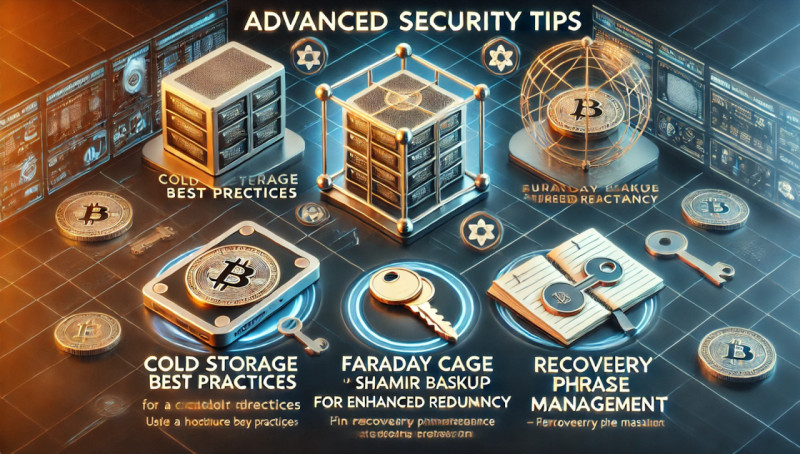
1. Cold Storage Best Practices
Offline methods are highly secure but require careful managing to avoid loss or exposure.
- Device isolation: use hardware tools only with trusted, malware-free devices. Avoid public or shared computers;
- Secure location: store devices in safes or safety deposit boxes. Keep them out of exposed or easily accessible areas;
- Firmware updates: regularly update devices to protect against new vulnerabilities;
- Offline setup: configure devices offline to prevent interception during setup.
These precautions secure offline solutions from physical along with digital threats.
2. Using a Faraday Cage
Electromagnetic interference (EMI), radio frequency (RF) attacks, though rare, can compromise devices. A Faraday cage blocks signals, preventing unauthorized scanning.
- How it works: blocks electromagnetic signals, protecting contents from interception;
- Usage: store hardware or paper backups in a Faraday pouch or box, especially in high-security environments or during travel;
- DIY options: use aluminum or copper mesh to create a basic Faraday cage.
This layer reduces exposure to advanced surveillance or hacking when deciding where to store cryptocurrency.
3. Shamir Backup for Enhanced Redundancy
Shamir’s technique splits sensitive data into multiple parts, ensuring no single piece can restore access.
- How it works: divide recovery phrases into segments, requiring a minimum number (e.g., three of five) to recover access;
- Benefits:
- Reduces complete loss risk if one segment is misplaced;
- Prevents unauthorized access with insufficient segments;
- Storage: distribute pieces across safes, trusted relatives, or safety deposit boxes.
This method combines security together with redundancy, ideal for long-term investors.
4. Hardware PIN, Recovery Phrase Management
Physical tools rely on PINs, recovery phrases, which need careful management to prevent exposure.
- PIN security:
- Use complex, unique PINs;
- Avoid writing the PIN near the device;
- Enable lock features after failed attempts, if available;
- Recovery Phrase Protection:
- Write phrases on durable materials like metal plates to prevent damage;
- Never store phrases digitally to avoid cyber risks;
- Store multiple copies in separate, secure locations.
Proper management ensures unauthorized access remains unlikely, even if devices are lost or stolen.
Building a Comprehensive Security Framework
Advanced techniques — proper offline managing, Faraday cages, Shamir backups, careful PIN/recovery phrase management — bolster protection, provide peace of mind. When choosing the storage solution, these strategies add complexity for attackers while enhancing control over holdings.
Risks, Common Mistakes
Mismanaging digital investments can cause serious losses, even for experienced users. Knowing ways to secure digital assets is just the first step — knowing risks, avoiding pitfalls is equally critical. Here are common mistakes and how to mitigate them.
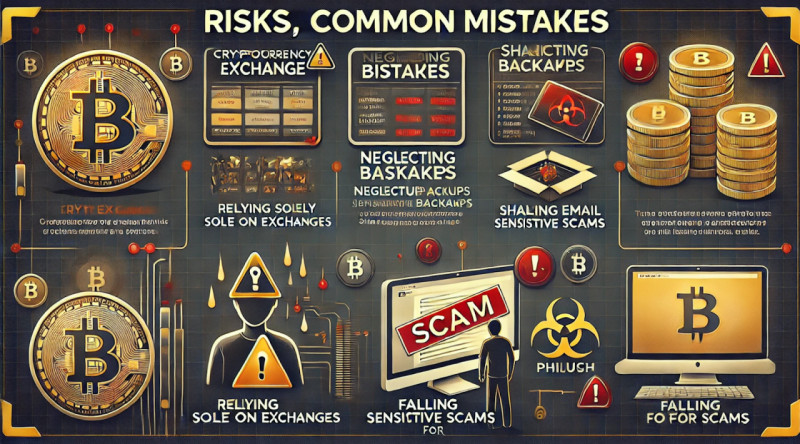
1. Relying Solely on Exchanges
Exchanges are convenient for buying, selling, trading but come with significant risks. Many users leave funds on these platforms, assuming they’re fully secure.
- Exchange failures: platforms may go bankrupt or face liquidity issues, leaving users without access. Mt. Gox’s 2014 collapse caused $450 million in losses;
- Hacks: centralized exchanges are frequent targets for attackers. In 2019, Binance lost $40 million in a breach;
- Regulatory risks: governments may restrict platforms, freeze accounts, or force withdrawals under unfavorable terms;
- Mitigation: use exchanges only for transactions, transfer holdings to more secure solutions immediately. Diversify across platforms to reduce impact from a single failure.
2. Neglecting Backups
Failing to back up credentials is a common mistake, often leading to permanent loss of funds. Many underestimate backup importance until it’s too late.
- Lost devices: hardware tools or apps can be lost, damaged, or stolen, making recovery impossible without a backup;
- User error: deleting files or failing to save recovery phrases can lock users out permanently;
- Real-life example: a man lost millions by discarding a hard drive with his credentials. Efforts to recover it from a landfill failed;
- Mitigation: create multiple backups of recovery information. Store them securely in fireproof safes, safety deposit boxes, or on durable materials like metal plates.
3. Sharing Sensitive Information
Keeping credentials confidential is fundamental. Sharing access details, even with trusted people, risks theft or misuse.
- Social engineering: scammers pose as customer support or technical experts to extract sensitive information;
- Unintended access: sharing credentials with friends or family can lead to unauthorized transfers or errors;
- Insider risks: many thefts involve insiders misusing access;
- Mitigation: never share sensitive details, even with trusted parties. Use multi-signature setups for shared accounts, requiring multiple approvals for transactions when thinking of where to store cryptocurrency.
4. Falling for Scams
Scammers frequently create new methods to exploit users, from phishing websites to fake apps.
- Phishing: fake platforms mimic legitimate ones to steal credentials;
- Malicious apps: fraudulent apps on official stores may steal sensitive data;
- Social media scams: impersonators posing as influencers or support agents solicit funds or access information;
- Mitigation:
- Verify URLs, use only official sites or apps;
- Check platform legitimacy through reviews or trusted sources;
- Be cautious of unsolicited messages or offers that seem too good to be true.
Avoiding Pitfalls
Knowing these risks, taking proactive steps reduces the chances of loss or theft. Avoid relying solely on exchanges, ensure backups, keep credentials private, stay alert to scams. Knowing ways to store digital assets safely is just one part — continuous improvement in security practices ensures long-term protection for your digital wealth.
Emerging Trends in Crypto Storage
The evolving digital finance landscape introduces innovations transforming how holdings are managed. Emerging trends address growing needs for security, accessibility, functionality. Comprehending these advancements helps make informed decisions about ways to secure cryptocurrency while staying ahead of risks.
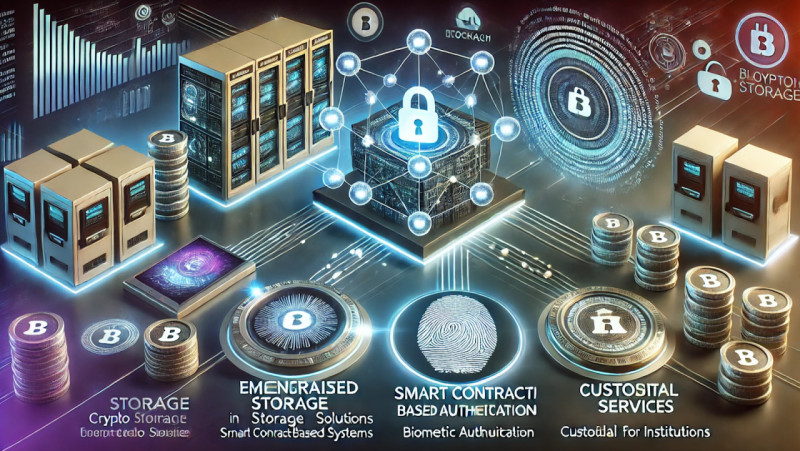
1. Decentralized Storage Solutions
Centralized systems are vulnerable to breaches along with failures, driving interest in decentralized alternatives. These systems distribute data across nodes, reducing reliance on single entities, improving security.
- IPFS (InterPlanetary File System): peer-to-peer network storing, sharing data securely across distributed nodes, preventing single points of failure;
- Filecoin: built on IPFS, incentivizes users to rent unused storage space, creating a secure, easily retrievable decentralized network.
Advantages:
- Resilience against attacks, downtime;
- Enhanced privacy via distributed management;
- Transparent, user-controlled systems.
Use cases: ideal for avoiding centralized vulnerabilities, storing sensitive documents, backups, or managing digital asset components.
2. Smart Contract-Based Solutions
Smart contracts are programmable agreements executing automatically under predefined conditions, enhancing security as well as flexibility for managing digital holdings.
- Programmable features: includes time-locked access, automated transfers, conditional approvals. Example: releasing assets after multiple approvals;
- Recovery mechanisms: allows trusted contacts to restore access if primary credentials are lost.
Advantages:
- Customizable for user needs;
- Minimizes reliance on intermediaries for complex transactions;
- Reduces errors through automated execution.
Use cases: suited for advanced users, businesses, developers creating tailored security solutions.
3. Biometric Authentication
Biometric technology secures access by leveraging unique physical traits, offering convenience along with protection.
- Fingerprint scans: quick, secure identity verification widely adopted in smartphones;
- Retina scans: highly accurate by analyzing eye patterns;
- Facial recognition: hands-free authentication integrated into many devices.
Advantages:
- Eliminates reliance on passwords prone to loss or theft;
- Combines security together with convenience for frequent access;
- Reduces risks of stolen credentials.
Use cases: ideal for casual users managing smaller amounts or high-frequency traders needing quick, secure access.
4. Custodial Services for Institutions
As digital assets gain mainstream acceptance, institutional investors need scalable, secure solutions for managing substantial portfolios. Custodial services meet these requirements.
- Specialized platforms: providers like Anchorage or BitGo offer institutional-grade systems with multi-layered security, compliance, insurance;
- Cold custody services: offline solutions maximize safety for long-term holdings;
- Auditing, reporting: tools for tracking, generating reports, ensuring compliance.
Advantages:
- Simplified management for large-scale investors;
- Reduced risk through insured holdings, regulatory compliance;
- Support for complex operations like fund transfers as well as staking;
Use cases: essential for hedge funds, corporations, high-net-worth individuals managing multi-million-dollar portfolios.
Shaping the Future of Digital Security
Emerging trends redefine where to store cryptocurrency. Decentralized systems enhance security by reducing central authority reliance, smart contracts offer unparalleled customization, biometrics simplify access, institutional services address large-scale needs. Adopting these innovations keeps users ahead of threats while leveraging the potential of digital asset management.
Conclusion
The question of finding the best storage solution is more than technical — it’s essential for protecting your financial future. Properly managing digital assets can preserve investments along with prevent avoidable losses. With evolving threats, innovations, prioritizing security is vital.
The Critical Role of Secure Practices
The digital economy lacks traditional safety nets. Unlike banks offering fraud protection or recovery, securing digital holdings is your sole responsibility. Neglect or mismanagement can lead to irretrievable losses.
- Safeguards protect funds from cybercriminals, technical failures, errors;
- Combining offline as well as online methods reduces reliance on a single solution;
- Tools like biometric authentication, decentralized systems add extra layers of protection for significant holdings or complex needs.
Security ensures confidence along with active participation in the digital economy.
The Power of Due Diligence
Managing digital assets securely starts with informed decisions. Convenience or popularity alone doesn’t ensure safety.
- Research: examine reputation, security features, user reviews of platforms before committing;
- Assess needs: traders may prioritize convenience, while long-term holders should focus on security;
- Stay updated: evolving tools along with threats require ongoing education, adaptation.
Evaluating options carefully builds confidence as well as improves management.
A Call to Action
Your setup may seem adequate, but security must adapt. Threats evolve, tools improve, yesterday’s strategies might no longer suffice. Evaluate your current approach:
- Review practices:
- Are credentials backed up securely?
- Do you combine online and offline methods?
- Are authentication methods strong?
- Identify risks:
- Have you relied solely on exchanges?
- Are tools outdated or inadequate?
- Is your approach diversified?
- Take action:
- Add advanced security features like multi-signature approval or biometrics.
- Create backups, store them securely in multiple locations.
- Monitor trends to keep strategies aligned with new threats.
Empowering Yourself for the Future
The digital asset space offers vast opportunities but requires proactive security. Knowing where to store cryptocurrency, using effective practices is essential for protecting your financial future. Acting now ensures confident, successful participation in the growing digital economy.
Recommended
How to Mine Cryptocurrency on PC
How to Mine Cryptocurrency on iPhone
How to earn interest on cryptocurrency





